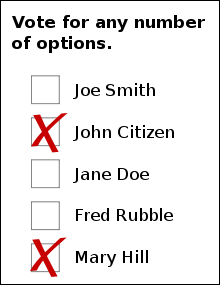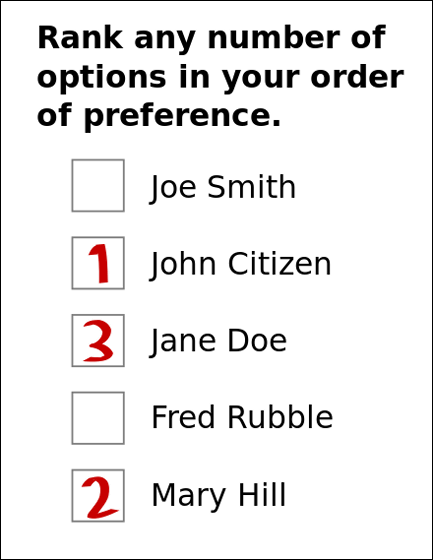What kind of election method can reflect public opinion more than "majority vote"?

ByAngela Radulescu
The "majority voting method" in which one who got the most votes is elected is adopted not only in Japan but also around the world as a general election method. However, if there are three or more candidates, even if more than half people oppose it, it is inevitable that a winner will appear, so it has been pointed out that it is not necessarily reflective of the people's will and better voting The method is being sought.
Voting in Organizations, Clubs, Meetings, and Families
http://democracychronicles.com/voting-in-organizations-clubs-meetings-and-families/
◆ Problems of majority vote
In many elections such as national elections and local elections in Japan, voting by "majority vote" is adopted. In a general majority vote, a simple and clear rule that a voter votes for only one person who wishes to be the most favorable (a person who wishes to win), and a person who won the most votes gets elected, but various problems Has been pointed out.
In a majority voting system that can vote only for the best person, there is a problem that voter's subtle intentions are hard to be reflected. For example, even if it is necessary to truncate either one of two candidates with almost no difference, or conversely, even if it is absolutely not desired that only this candidate won the prize, that intention will be cast to other candidates It is only reflected indirectly in the form of.
Also, if your supporters are weak candidates with no chance of winning, their supporters will vote for weak candidates and become "voting for death", but if they do not support it, they will not be supported "candidate" Tactical voting behavior to voteStrategic vote) Can be taken. However, this may not be a pure "reflection of the people's will".
In addition, if there are candidates (C) who do not want to be elected by any means, supporters of other candidates (A and B) cooperate to unite and vote for B so as to drop C, It is possible that B will be elected rather than a lot of supporters who could have won the vote (chicken's dilemma). All of these are fundamental reasons why you have to choose only one person in majority vote and have to truncate all other candidates.
Improvement of majority vote
Since only one "absolute justice" can be chosen, various mechanisms of voting are considered to solve the problem of majority vote where "information volume" is small.
Approval voting
One method is "Approval votingA method called called. This means that you can choose between OK for winning each candidate and x for winning NG. You can put a shade on the vote by supporting neither the candidate who is hard to put on it or just putting a cross on people who just do not want to win. However, it is impossible to put in superiority or inferiority among candidates with ○ or x, so it is still the same as a simple majority decision that we can not reflect accurate intent.

· Multiple voting system
With one majority vote, when the vote rate competes, it is inevitable that more than half of people do not want to win, but someone who will win will come out. In order to avoid such inconvenience, "multiple votes" to propose "majority support" as the winning requirement has been proposed and actually adopted for elections all over the world.
In the multiple voting system, if candidates who acquire a vote rate of 50% or more do not appear in the first vote, voting is repeated with excluding candidates with low vote rate, and ultimately the vote rate of 50% or more Voting will continue until a candidate who wins. Even if it finally becomes a final ballot, even though the winner will decide by "support of a majority", it can be said that the public opinion is easy to reflect, but the voting must be repeated many times before the winner decides I have a big problem in terms of management.
Boulder score
In the voting system that does not give relative / absolute superiority / inferiority between candidates, if it is not possible to reflect the popular mean well, it is only necessary to be able to rank the candidates, ranking all candidates and placing them in that rank Give points accordinglyBoulder scoreThe system is an effective means. However, under the Bolda scoring system, strategic voting is inevitable. For example, ranking the person who wants to win is ranked first, of course, but you can easily assume a voting behavior that keeps points down by making the candidate who is considered the biggest rival the lowest.
◆ Condorse system
Like the Bolda scoring method, the voting method which ranks the candidates' superiority or inferiority as the voting method with the ranking of candidatesPreference poll) There are.

As the preference voting system, even if candidates winning all winners (Condorceth winner) winners when winning each candidate on a one-to-one basis after ranking the candidates superior or inferior, even if the winner of Condorcas does not appear The Condorse method of winning candidates who won relatively more candidates has been proposed for a long time. However, with the Condorse system, circulation can appear in the order of selection as a group like a rock scream "Inversion of votingThe problem of the French mathematician of the 18th centuryNicolas de CondorçaIt is pointed out by and not universal.

· Sequential Pairwise Voting
For this reason, Sequential Pairwise Voting (SPV) has been devised to determine the preference ranking in the winning battle method as a means to solve the problem of the Condorche method, but a new problem that the candidate who wins by the match sequence can change . The problems of SPV are explained in the following movies in an easy-to-understand manner.
Math for Liberal Studies: Sequential Pairwise Voting - YouTube
When four candidates A, B, C and D were voted by the Condorcation method, five patterns were ranked and the most frequent was 14 votes in the order of preference of "B> C> D> A" Was put in. In other words, in case of a majority vote, it is a case that B who gathered 14 votes won at the top.

Since this election is the SPV system, a "one-on-one" tournament will be held based on voting. It seems that the tournament will be held in a tournament like the one below (Agenda DACB).

The first round is D vs. A. Of the 5 patterns, the relative win / loss of D and A are as shown in the table on the right, and D wins at 28 to 15.

C and D won the first round and C victory over 13 vs. 30.

The final battle of C and B who won the second round was B victory with 20 vs 23.

In this case as well as a majority vote will result in B being elected.

How about a tournament like this (Agenda BADC) changing the battle order?

The first round is B versus A. B victory at 28 to 15.

However, in the second round D won B.

And C wins the final battle.

That's why C won the prize. In this way, there is a possibility that the winner will change depending on the battle order in the SPV, so there is a problem that it is possible to change the winner arbitrarily by operating the match order.

· Condorse IRV
In the absence of candidates who gather support for a majority by the vote by the Condorcate method, the candidates' votes with the fewest numbers (top votes) backed up in the "No. 1" ranking are ranked by the remaining candidates Respond accordingly, continue exclusion of candidates until candidates with top votes more than 50% appear again and ultimately decide the winnerInstant-runoff voting(Condorse IRV) has been devised. Unlike multiple voting systems, the Condorsa IRV has been adopted in national elections in Australia because it requires only one vote and no cost to voting work.

· Schulz system
Schulz system, The rule that "OK if you give rank only to candidates who want to compete superiority or inferior (to win)" OK if you put the same rank to multiple candidates as "Condorse" method is added, Strength of the candidate "to calculate the superiority / inferiority relation among the candidates and make the best person a winner. Although it has the clarity that the prize winner will be determined by calculation complementing the fatal shortcomings of the Condorcation method that the winner is not elected by Schulz's method, since the calculation process is complicated, the winner determination The problem remains that the process is difficult to understand.

The voting methods listed here are only a small part of the proposed method to replace the majority vote in the case of electing only one elected winner and select multiple winnersMajor constituency system, And the winners will be elected according to the vote rate of political parties (certain groups)Proportional representation systemThere are also ways to realize more democratic elections with different frameworks. Although,Arrow's impossibility theoremIt is also true that "There is no perfectly equitable election system" as you can cast. However, an electoral system that is more democratic and capable of realizing maximum happiness of society is indispensable, and it is thought that research will be continued looking for answers that can not be found for ever in the future.
Related Posts:
in Note, Posted by darkhorse_log







